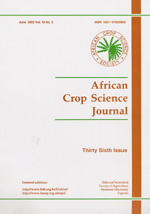
|
African Crop Science Journal
African Crop Science Society
ISSN: 1021-9730
EISSN: 1021-9730
Vol. 24, No. 2, 2016, pp. 155-166
|
 Bioline Code: cs16030
Bioline Code: cs16030
Full paper language: English
Document type: Research Article
Document available free of charge
|
|
|
African Crop Science Journal, Vol. 24, No. 2, 2016, pp. 155-166
| en |
ADAPTATION OF INTRODUCED MUNGBEAN GENOTYPES IN UGANDA
MBEYAGALA, E. K.; AMAYO, R. & OBUO, J. E. P.
Abstract
Mungbean ( Vigna radiata

(L.) Wilczek) is an important source of nutrients and income for smallholder farmers in East Africa. Mungbean production in countries like Uganda largely depends on landraces, in the absence of improved varieties. In order to enhance productivity, efforts have been underway to develop and evaluate mungbean varieties that meet farmers’ needs in various parts of the country. This study was conducted at six locations in Uganda, to determine the adaptability of introduced mungbean genotypes, and identify mungbean production mega-environments in Uganda. Eleven genotypes (Filsan, Sunshine, Blackgram, Mauritius1, VC6148 (50-12), VC6173 (B-10),Yellowmungo, KPS1, VC6137(B-14),VC6372(45-60),VC6153(B-20P) and one local check were evaluated in six locations during 2013 and 2014. The locations were; National Semi Arid Resources Research Institute (NaSARRI), Abi Zonal Agricultural Research and Development Institute (AbiZARDI),Kaberamaido variety trial center, Kumi variety trial center, Nabuin Zonal Agricultural Research and Development Institute (NabuinZARDI), and Ngetta Zonal Agricultural Research and Development Institute (NgettaZARDI). G × E interactions were significant for grain yield. Through GGEBiplot analysis, three introduced genotypes (Filsan, Blackgram and Sunshine) were found to be stable and high yielding, and therefore, were recommended for release. The six test multi-locations were grouped into two candidate mega-environments for mungbean production (one comprising of AbiZARDI and Kaberamaido and the other comprising of NaSARRI, NabuinZARDI, Kumi, and NgettaZARDI). National Semi Arid Resources Research Institute (NaSARRI) was the most suitable environment in terms of both discriminative ability and representativeness and therefore can be used for selection of widely adaptable genotypes.
Keywords
Biplot; mega-environment; Vigna radiata
|
| |
| fr |
MBEYAGALA, E. K.; AMAYO, R. & OBUO, J. E. P.
Résumé
La fève ( Vigna radiata

(L.) Wilczek) est une importante source de nutriments et de revenu pour les paysans en Afrique de l’Est. La production de la fève dans des pays comme Ouganda dépend largement des variétés locales, à défaut des variétés améliorées. Dans le but d’accroitre la productivité, des efforts ont été fournis pour développer et évaluer les variétés de fèves pouvant satisfaire les besoins des producteurs dans différents coins du pays. La présente étude a été conduite dans six emplacements en Ouganda, en vue de déterminer l’adaptabilité de variétés introduites de fèves et identifier les zones majeures de production de fèves. Onze variétés introduites (Filsan, Sunshine, Blackgram, Mauritius1, VC6148 (50-12), VC6173 (B-10),Yellowmungo, KPS1, VC6137(B-14),VC6372(45-60),VC6153(B-20P) et une variété locale utilisée ici comme témoin, ont été évaluées dans six emplacements au cours des années 2013 et 2014. Les emplacements étaient : l’Institut Nationale de Recherche sur les Ressources Semi-Aride (NaSARRI), l’Institut Zonale de Recherche Agricole et Développement de Abi (AbiZARDI), le centre d’expérimentation des variétés de Kaberamaido, le centre d’expérimentation des variétés de Kumi, l’Institut Zonale de Recherche Agricole et Développement de Nabuin (NabuinZARDI) et l’Institut Zonale de Recherche Agricole et Développement de Ngetta (NgettaZARDI). L’interaction génotypes et environement G × E était significatif pour le rendement en grain. Une analyse se servant de biplot, a révélé trois stables variétées introduites (Filsan, Blackgram and Sunshine), ayant des rendements élevés. Ces trois variétées sont donc recommendées pour être lancées. Les six emplacements utilizes dans cette étude peuvent être groupés en deux grandes zones proprices à la production de la fève (la première zone est constituée de AbiZARDI et Kaberamaido, tandis que la seconde est faite de NaSARRI, NabuinZARDI, Kumi et NgettaZARDI). NaSARRI s’est révélé l’emplacement le plus propice, en ce sens que cet emplacement était le plus discriminant et le plus représentatif, et de ce fait peut être utilisé pour sélectionner des variétées à large adaptation.
Mots Clés
Biplot; zones majeures; Vigna radiata
|
| |
© Copyright 2016 - African Crop Science Journal
|
|
